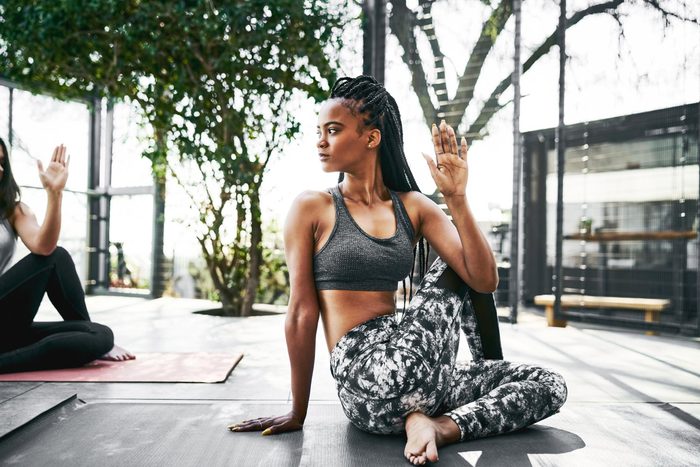6 Major Benefits of Doing Yoga Every Day, from Experts

Registered yoga teachers, doctors, and mental health professionals share their takes on the powerful health advantages of stepping onto your yoga mat daily.
Sometimes it’s the simplest daily practice that can have the biggest impact on your health, and yoga is proof of that. Although most forms of yoga aren’t considered to be as intense as other workout regimens (think your average cycling class!), practicing yoga on a daily basis has been scientifically demonstrated to help you mentally and physically. Through breath work, meditation, and holding poses that increase strength and flexibility, the body and mind reap benefits from yoga that positively impact your long-term health. It’s no wonder people have been practicing yoga for over 5,000 years, and that the number of Americans practicing yoga doubled between 2012 and 2016 to nearly to 40 million, according to the Yoga Alliance.
In order to get the full scope of what practicing yoga daily can really do for your body, The Healthy @Reader’s Digest spoke with several experts who have seen the ways yoga has positively benefited their students, patients…and even themselves.
Yoga assists with mood regulation
Jenni Tarma, an ERYT500 yoga teacher and Yoga Medicine Therapeutic Specialist, shares, “We have a wealth of research demonstrating that a regular mindfulness practice—the act of paying attention to the sensation in the body, thoughts, and emotions without judgment—can reduce stress, and help us to feel calmer, more productive, and generally more even-keeled in our daily lives.”
After evaluating yoga history and research, one 2014 review published in Frontiers in Human Neuroscience concluded that regular yoga practice can help facilitate self-regulation (the ability to understand and manage your behavior and reactions). Another study of adolescents between the ages of 13 and 18 found that practicing yoga positively benefited emotional regulation and self-esteem. “Movement releases beneficial neurotransmitters in the brain, which helps us feel good as well as assist in mood regulation,” says Evan Lawrence, LMHC, CPT, and RYT200 yoga instructor. “One of the things that I like about yoga specifically is that there is simultaneously a focus on physical movement and breathing.”
Yoga builds up your core strength
Gina Newton, NASM certified personal trainer and RYT200 yoga teacher, says, “From a physical perspective, yoga is so great for increasing our core strength, which should be a non-negotiable part of every human’s workout. Newton adds, “We all need our core—and especially women who have been pregnant or had children, our core strength is something we need to care for and nurture to hold us up.”
According to Harvard Medical School, a stronger core benefits the body in multiple ways, including providing better posture, balance, stability, relief for lower back pain, and support through daily tasks like cleaning, working, and athletic activities or exercise.
Yoga reduces stress
“Yoga and meditation are powerful tools for stress resilience and strengthening mental health,” says Nicole Renée Matthews, RYT200 and director of Yoga at Newport Healthcare. “Doing yoga regularly promotes mental clarity and calmness, centers and relaxes the mind, helps to relieve stress patterns and anxiety, and boosts concentration and focus.”
One 2010 study from the Journal of Alternative and Complementary Medicine concluded that practicing yoga can improve mood and decrease anxiety even more than a regular walking practice after participants finished a 12-week program. Researchers have also found that the breathing techniques involved with yoga can be part of what benefits decreased anxiety during practice.
“Breath awareness, another key component of yoga, has been shown to reduce physiological markers of stress, especially when using techniques such as ‘belly breathing’—breathing deeply so that the abdomen expands, rather than exclusively using a shallow chest breath—and elongating the exhalation,” says Tarma. “These techniques help to activate the parasympathetic nervous system, which in turn leads to less anxiety, jitteriness, and improved sleep; all things that can improve our mental health on a day-to-day basis.”
Yoga improves brain health
According to Dr. Gail Saltz, MD, associate professor of psychiatry at the New York Presbyterian Hospital Weill-Cornell School of Medicine, practicing yoga “improves overall blood flow to the body, including the brain, [which is] helpful for cognition and memory.”
One 2019 review published in Brain Plasticity concluded that behavioral interventions like yoga can help “mitigate age-related and neurodegenerative decline” due to the positive effects a daily practice has on different parts of the functioning brain, like the hippocampus (which plays a major role in learning and memory) and the prefrontal cortex (cognitive control functions).
Yoga improves flexibility and mobility
“Physically, daily yoga practice allows us to engage our muscles and move through larger ranges of joint motion than we do typically moving through life,” says Lawrence. “This helps to keep us limber and flexible.”
“Dedicated, daily yoga practice helps with flexibility and strength, which can help improve your posture, as well as balance,” says Samantha Hoff, 200-YTT yoga instructor and founder of Pottery with a Purpose. “On the physical side, it also helps with joint mobility since you’ll take your joints through most—or all—of their ranges of motion.”
Yoga strengthens muscle and endurance
“From a musculoskeletal perspective,” says Tarma, “yoga loads our bodies and joints in a wide variety of positions and scenarios: think longer static holds in poses that challenge our tissues’ endurance, or controlled transitions between shapes that develop strength, control, and coordination. These different facets of our movement capabilities all contribute to better overall function and load-tolerance capacity. As an added bonus, because most styles of yoga are bodyweight only and move at a very moderate speed, yoga is also a generally very accessible and safe movement modality.”

No comments